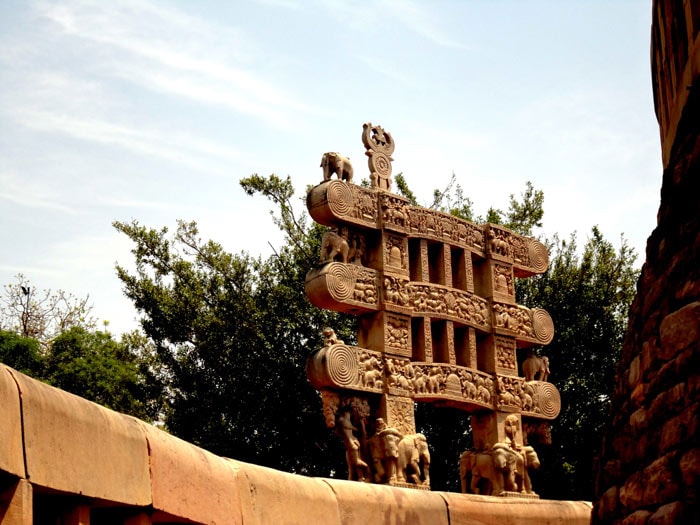Sanchi Stupa: Things you would want to know about the monument
I happened to visit Sanchi in 2013, and experienced its several many hues.
 Sanchi Stupa (Source: Swasti Pachauri)
Sanchi Stupa (Source: Swasti Pachauri)
I happened to visit Sanchi in 2013, and experienced its several hues, which even the colourful Ogilvy & Mather advertisement echoed with its incredible “Rang hai, Malang hai, Sau tarah ke Rang hai’, jingle.
The state of Madhya Pradesh is a perfect confluence of different kinds of heritage- natural, cultural and aesthetic. What is truly epic about its cultural repository are some of the geographical aspects emanating from history, and well, geology. Take for instance, the Tropic of Cancer line that passes through Vidisha district, a common stopover for enthusiasts’ enroute to the glorious Sanchi Stupas.
 The Tropic of Cancer line that passes through Vidisha district, a common stopover for enthusiasts’ enroute to the glorious Sanchi Stupas. (Source: Swasti Pachauri)
The Tropic of Cancer line that passes through Vidisha district, a common stopover for enthusiasts’ enroute to the glorious Sanchi Stupas. (Source: Swasti Pachauri)
Sanchi, needs no introduction. A UNESCO World heritage site located in Raisen district of Madhya Pradesh, Sanchi Stupas reveal richness of Indian heritage, the country’s enormous cultural inventory, and lessons from post Mauryan craftsmen on architecture and arts.
A typical stupa comprises of a semi-spherical dome, circumambulatory pathways called Pradakshinapatha along with pillared structured gateways called Toranas, also the most evocative in a Stupa’s architectural style. These Toranas have Jataka stories which narrate previous births of Buddha, and narrative depiction of several of Buddha’s life events. For instance, the most popular and famous Queen Maya’s dream with the descending elephant. These events along with Jataka stories of Buddha, contributed to an important aspect of decor, semblance of which is seen in contemporary wall painting styles in the countryside, today. While their thematic essence might differ, the provenance of style and most importantly of creative imagination and thought, remain unanimous across different eras of art demonstration.
 Torana Pillar (Source: Swasti Pachauri)
Torana Pillar (Source: Swasti Pachauri)
This particular terrain is rich with several other antique sites, the most stunning of them being of Bhimbetka rock shelters (another UNESCO heritage site in Raisen district) proximate to Vindhya ranges, housing prehistoric paintings depicting early life and primitive occupations, man-man/ man-wild relationships – emblematic of a unique symbiosis that existed in those golden days of sacred groves.
Various styles, stone carvings and narrative art depiction through stories are few features of these prodigious structures that boast of richness and authenticity of ancient murals. The most fascinating aspect about our prehistoric era is the austerity and grandeur, with which these monumental structures stand the test of time.
The relevance of these styles is evident in wall paintings and murals, seen in rural India during customary celebrations of harvest or say, nuptials. Instance, if limestone (chuna), chalcedony, haemtite (red geru), stones and bricks were used during paleolithic era to beautifully narrate the continuum of human saga and man’s relationship with nature and wild- similar creative expressions find refuge on traditional folk paintings of today, depicting how important it was, and still is to creatively narrate daily rituals of life. Together, these paintings, and rock art murals contribute to a repertoire of historical anecdotes to learn from, thus nourishing our artistic acumen.
It is not surprising therefore, that present day Warli and Pithora art derive their inspiration from ancient rituals of socio-economic activity, thus corroborating to the seminal values, prehistoric architectural style passed on to generations, leaving behind meticulous imprints of imaginative story telling exercises. In fact, these story narrations, (albeit with different content and message) resonate with the innovative ‘Communications for Development’ methodologies based on visual appeals, deployed by organizations these days, to maximize developmental outreach of their welfare programmes.
Last week, our Honourable PM invoked Buddha and his teachings, his contributions to peace and humanity. From Sri Lanka, Japan, Nepal, China, to even Mongolia now, the present dispensation’s focus on enhancing friendships through common cultural roots of Buddhist teachings, is testimony to the present day relevance of invoking Buddhism and its spiritual significance, in our daily lives.
It is indeed, one of the many ways to connect and establish amity with people, and nations through several conservational efforts ranging from preserving heritage sites, to prospering sustainable tourism initiatives. Such efforts generate knowledge capital, and encourage avenues for meaningful intellectual and spiritual exchange, while balancing the essentials of soft power, and furthering cultural diplomatic ties. India’s pivotal role in construing Nalanda International University establishes a case in point, to how an ancient seat of Buddhist learning could be harnessed towards cementing global learning capital, and cultural diplomacy.
Domestically speaking, government programmes have been undertaken to promote tourism, conservation, and preservation of important Buddhist sanctuaries. The recently lauched ‘Swadesh-Darshan’ which focuses on developing a Buddhist circuit connecting Bodh Gaya, Rajgir, Vaishali in Bihar and Kapilavastu, Sarnath, Shravasti, Kushinagar in Uttar Pradesh- is a promising step towards preserving heritage and history, thus reviving ethos of ancient culture.




- 01
- 02
- 03
- 04
- 05






















